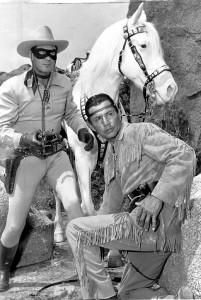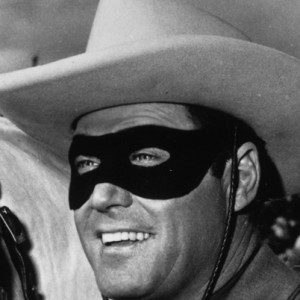The Lone Ranger
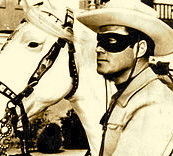
The Lone Ranger: Journey To San Carlos
The Lone Ranger is the central character of an American animated television series that ran 26 episodes on CBS from September 10, 1966, to September 6, 1969. The series was produced by Herb Klynn and Jules Engel of Format Films, Hollywood, and designed and made at the Halas and Batchelor Cartoon Film studios in London, England & Artransa Park Studios in Australia.
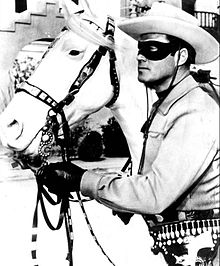 Clayton Moore as the Lone Ranger
Clayton Moore as the Lone Ranger
The fictional character Lone Ranger is a masked ex-Texas Ranger who, with his Indian friend Tonto, fights injustice in the American Old West. The character has become an enduring icon of American culture.
He first appeared in 1933 in a radio show conceived either by WXYZ (Detroit) radio station owner, George W. Trendle, or by Fran Striker, the show’s writer. The character was inspired by Texas Ranger Captain John R. Hughes, to whom the book “The Lone Star Ranger” by Zane Grey, was dedicated in 1915. Hughes hunted down the gang who killed Texas Ranger Captain Frank Jones in an ambush. The show proved to be a hit and spawned a series of books (largely written by Striker), an equally popular television show that ran from 1949 to 1957, and comic books and movies. The title character was played on radio by George Seaton, Earle Graser, and most memorably Brace Beemer. To television viewers, Clayton Moore was the Lone Ranger. Tonto was played by, among others, John Todd, Roland Parker and in the television series, Jay Silverheels.
Departing on his white stallion, Silver, the Lone Ranger would shout, “Hi-Yo, Silver! Away!” As they galloped off, someone would ask, “Who was that masked man, anyway?” Tonto usually referred to the Lone Ranger as “Ke-mo sah-bee“, supposedly meaning either “trusty scout” or “trusted friend,” or in the 2013 Hollywood version “wrong brother.” These catchphrases, his trademark silver bullets, and the theme music from the William Tell Overture have become tropes of popular culture.
Origin
The Lone Ranger is so named because the character is the last survivor of a group of Texas Rangers, rather than because he works alone (he is usually accompanied by Tonto).
While details differ, the basic story of the origin of the Lone Ranger is the same in most versions of the franchise. A posse of six members of the Texas Ranger Division pursuing a band of outlaws led by Bartholomew “Butch” Cavendish is betrayed by a civilian guide named Collins and ambushed in a canyon named Bryant’s Gap. Later, an Indian named Tonto stumbles onto the scene and discovers one ranger is still alive, though barely. (In some versions, Tonto recognizes the lone survivor as the man who saved his life when they were children; according to the television series, when Tonto left the Reid place with a horse given him by the boy Reid, he gave Reid a ring and the name Kemo Sabe, which he said means “trusty scout.” He nurses the man, whom the radio show eventually established as being named John Reid, back to health. Among the Rangers killed was John’s older brother, Daniel Reid, who was a captain in the Texas Rangers and the leader of the ambushed group. John Reid fashions a black domino mask, using material from his brother’s vest to conceal his identity. To aid in the deception, Tonto digs a sixth grave and places at its head a cross with John’s name so that Cavendish and his gang would believe that all of the Rangers had been killed.
In many versions Reid continues fighting for justice as The Lone Ranger even after the Cavendish gang is captured.
As generally depicted, the Lone Ranger conducts himself by a strict moral code based on that put in place by Striker at the inception of the character. Actors Clayton Moore and Jay Silverheels both took their positions as role models to children very seriously and tried their best to live by this creed. It reads:
I believe…
- That to have a friend, a man must be one.
- That all men are created equal and that everyone has within himself the power to make this a better world.
- That God put the firewood there, but that every man must gather and light it himself.
- In being prepared physically, mentally, and morally to fight when necessary for what is right.
- That a man should make the most of what equipment he has.
- That ‘this government of the people, by the people, and for the people’ shall live always.
- That men should live by the rule of what is best for the greatest number.
- That sooner or later…somewhere…somehow…we must settle with the world and make payment for what we have taken.
- That all things change but truth, and that truth alone, lives on forever.
In addition, Fran Striker and George W. Trendle drew up the following guidelines that embody who and what the Lone Ranger is:
- The Lone Ranger is never seen without his mask or a disguise.
- With emphasis on logic, The Lone Ranger is never captured or held for any length of time by lawmen, avoiding his being unmasked.
- The Lone Ranger always uses perfect grammar and precise speech completely devoid of slang and colloquial phrases, at all times.
- When he has to use guns, The Lone Ranger never shoots to kill, but rather only to disarm his opponent as painlessly as possible.
- Logically, too, The Lone Ranger never wins against hopeless odds; i.e., he is never seen escaping from a barrage of bullets merely by riding into the horizon.
- Even though The Lone Ranger offers his aid to individuals or small groups, the ultimate objective of his story never fails to imply that their benefit is only a by-product of a greater achievement—the development of the west or our country. His adversaries are usually groups whose power is such that large areas are at stake.
- Adversaries are never other than American to avoid criticism from minority groups. There were exceptions to this rule. He sometimes battled foreign agents, though their nation of origin was generally not named. One exception was helping the Mexican Juarez against French troops of Emperor Maximilian, as occurred in the radio episodes such as “Supplies for Juarez” (18 September 1939), “Hunted by Legionnaires” (20 September 1939) and “Lafitte’s Reinforcements” (22 September 1939).
- Names of unsympathetic characters are carefully chosen, never consisting of two names if it can be avoided, to avoid even further vicarious association—more often than not, a single nickname is selected.
- The Lone Ranger never drinks or smokes and saloon scenes are usually interpreted as cafes, with waiters and food instead of bartenders and liquor.
- Criminals are never shown in enviable positions of wealth or power, and they never appear as successful or glamorous.
Reid decides to use only silver bullets, to remind himself that life, too, is precious and, like his silver bullets, not to be wasted or thrown away.
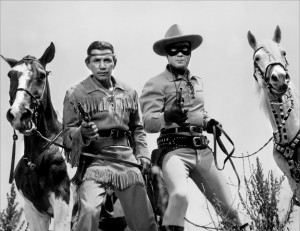 The Lone Ranger’s first name
The Lone Ranger’s first name
Although the Lone Ranger’s last name is given as Reid, his first name was not definitely specified as John until the 20th-anniversary radio program in 1953. As John Dunning explained in On the Air: The Encyclopedia of Old-Time Radio:
“It told how six Rangers chased the ruthless Butch Cavendish gang through the badlands to a final showdown at a place called Bryant’s Gap. The Rangers were headed by Capt. Dan Reid, and among those in his command was his younger brother, John. The Reid brothers had been partners in a rich silver mine strike before duty called, and were planning to return to the mine when their service with the Rangers was finished.”
Other radio reference books, beginning with Radio’s Golden Age (Eastern Valley Press, 1966), also give the Lone Ranger’s first name as John. While his first name was not mentioned in contemporary Lone Ranger newspaper comics, comic books, and tie-in premiums, the name John Reid is used in a scene in the 1981 film The Legend of the Lone Ranger, in which the surviving Reid digs an extra grave for himself. The name John Reid also appears in Dynamite Entertainment‘s licensed Lone Ranger comic-book series that began in 2006.
The name Luke Hartman is used in the 2003 TV-movie/unsold series pilot.
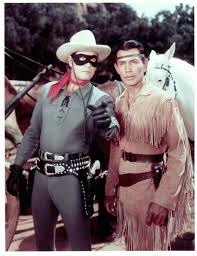 The character made his initial appearance in the 11th episode of the radio show. Fran Striker told his son that Tonto was added so the Lone Ranger would have someone to talk to. The radio program identified him as a member of the Potawatomi tribe, though some books say he was probably an Apache. He was named by James Jewell, who also came up with the term “Kemosabe” based on the name of a summer camp in upstate Michigan. In the local native American language, “Tonto” meant “wild one.”
The character made his initial appearance in the 11th episode of the radio show. Fran Striker told his son that Tonto was added so the Lone Ranger would have someone to talk to. The radio program identified him as a member of the Potawatomi tribe, though some books say he was probably an Apache. He was named by James Jewell, who also came up with the term “Kemosabe” based on the name of a summer camp in upstate Michigan. In the local native American language, “Tonto” meant “wild one.”
The character spoke in broken English, although the actor, Jay Silverheels, disliked this attribute.
Because Tonto means “foolish” or “silly” in Spanish, the character is renamed “Toro” (Spanish for “bull”) or “Ponto” in Spanish-speaking countries. Although the word Tonto in Portuguese has the same meaning as in Spanish, the name was kept in its original version in Portuguese-speaking countries in which the series was broadcast.
In the 2013 Hollywood film version of The Lone Ranger, Tonto is a Comanche tribesman.
Dan Reid Jr.
The name of Captain Reid’s son, the Lone Ranger’s nephew, a character introduced in the radio series who became a juvenile sidekick to the Masked Man, is named Dan Reid. When Trendle and Striker later created The Green Hornet, they made this Dan Reid the father of Britt Reid, alias the Green Hornet, thereby making the Lone Ranger the Green Hornet’s great-uncle. Throughout The Lone Rangerradio series, Dan was played by Ernest Winstanley, Bon Martin, Clarence Weitzel, James Lipton and Dick Beals.
The Lone Ranger’s nephew made his first appearance in “Heading North” (December 14, 1942) under the name “Dan Frisby”, the grandson of Grandma Frisby. The two lived in an area described as “the high border country of the northwest” near the town of Martinsville close to the Canadian border. This and the following four episodes (“Design for Murder”, December 16, 1942; “Rope’s End”, December 18, 1942; “Law of the Apex”, December 21, 1942; and “Dan’s Strange Behavior”, December 23, 1942) centered around a plot to steal the valuable Martin Copper Mine and Dan’s being fooled by a Lone Ranger impostor into helping him steal it. The Lone Ranger and the Mounties foil the plot and capture the impostor and his gang.
In the final episode of the arc, “A Nephew is Found” (December 25, 1942), the dying Grandma Frisby reveals to The Lone Ranger Dan’s true identity and how he came to be with her. Fifteen years previously, Grandma Frisby had been part of a wagon train traveling to Fort Laramie. Also on that wagon train had been Linda Reid, wife of Texas Ranger Captain Dan Reid, and her six-month-old son Dan Jr., who were traveling from their home in Virginia to join her husband. Before the wagon train could reach Fort Laramie, it was attacked by Indians and Linda Reid was among those killed. Grandma Frisby took charge and care of Dan Jr., but upon reaching Fort Laramie found two messages waiting: one that Captain Reid (voiced in this story by Al Hodge) had been killed in an ambush at Bryant’s Gap and the other that her own husband had been killed in an explosion. Taking Dan and certain items concerning his identity (including a small gold locket containing a picture of Dan’s parents and a picture of Captain Reid’s brother), Grandma Frisby travelled to Martinsville and raised Dan as her grandson.
On hearing this story, The Lone Ranger reveals his true identity and his own story to Grandma Frisby and promises that he will care for Dan like his own son. Before Grandma Frisby passes away, The Lone Ranger removes his mask and lets her see his face. Her last words are “Ride on, Lone Ranger … ride on forever … with Danny at your side.” The Lone Ranger takes the grieving Dan outside the cabin, gives him the locket and reveals their true relationship. Dan Reid Jr. would go on to be a recurring character throughout the remainder of the series, riding with The Lone Ranger and Tonto on his own horse Victor.
Eventually, Dan Reid Jr. would be sent East to gain an education, making infrequent appearances on the series whenever Fran Striker wanted to remind the audience of the family connection, and would later become part of The Green Hornet radio series, first appearing on October 22, 1936, establishing the connection between The Lone Ranger and The Green Hornet in the episode “Too Hot to Handle” (November 11, 1947) and being played throughout the series by John Todd, who played “Tonto” on The Lone Ranger radio series
According to the episode “The Legend of Silver” (September 30, 1938), before acquiring Silver, the Lone Ranger rode a chestnut mare called Dusty. The Lone Ranger saves Silver’s life from an enraged buffalo and, in gratitude, Silver chooses to give up his wild life to carry him.
The origin of Tonto’s horse, Scout, is less clear. For a long time, Tonto rides a white horse called White Feller. In “Four Day Ride” (August 5, 1938), Tonto is given a paint horse by his friend Chief Thundercloud, who then takes White Feller. Tonto rides this horse and refers to him simply as “Paint Horse” for several episodes. The horse is finally named Scout in “Border Dope Smuggling” (September 2, 1938). In another episode, however, the Lone Ranger, in a surge of conscience, releases Silver back to the wild. The episode ends with Silver returning, bringing along a companion who becomes Tonto’s horse Scout.
Whenever the Lone Ranger mounts Silver, he shouts, “Hi-yo, Silver! Away!” Besides sounding dramatic, this shout originally served to tell the radio audience that a riding sequence was about to start. Bill Cosby complained in his book Cosbyology that, when the TV version came around, the Lone Ranger still used the line for reasons he could not figure out. In an echo of the Lone Ranger’s line, Tonto frequently says, “Git-um up, Scout!” (The phrase became so well embedded in the Lone Ranger mythos that International Harvester used it as an advertising line to promote their Scout utility vehicle in the 1970’s.)
http://en.wikipedia.org/wiki/The_Lone_Ranger

